Photobiomodulation helps melt away stubborn fat by using low-powered red light to penetrate your fat tissue and trigger several fat-burning mechanisms. The light energy creates tiny pores in fat cell membranes while activating hormone-sensitive lipase, an enzyme that breaks down triglycerides. It also boosts your mitochondrial function and ATP production, powering up your body's natural fat-burning processes. You'll see enhanced results when you combine this therapy with exercise, as physical activity helps your body utilize the released fat through the lymphatic system. Understanding the complete process can help you maximize your fat loss journey.
Understanding Photobiomodulation for Fat Loss

Through recent scientific advances, photobiomodulation has emerged as a promising approach for fat reduction. This non-invasive treatment works by stimulating your body's natural fat-breakdown mechanisms, primarily through the activation of hormone-sensitive lipase.
When you undergo photobiomodulation, red light penetrates your tissue and triggers increased cyclic AMP levels, which enhance your mitochondrial function and ATP production. The therapy employs low-powered red light that safely penetrates the skin without generating harmful UV rays.
You'll find that photobiomodulation doesn't destroy your fat cells like laser lipolysis does. Instead, it helps reduce their size by causing adipocytes to release triglycerides. The treatment also improves your lymphatic drainage, which helps diminish the appearance of cellulite while aiding in fat removal.
What's particularly interesting is that photobiomodulation selectively targets unhealthy adipose tissue while leaving healthy fat cells relatively unaffected.
However, you should know that results can vary, and there's a threshold limit to its effectiveness. For the best outcomes, you'll need to combine this treatment with a healthy lifestyle – including proper diet and exercise. The treatment works most effectively if you're dealing with obesity-related conditions, as its fat-reduction capabilities are significantly disease-dependent.
The Science Behind Fat Melting
Light waves, when precisely targeted at fat deposits, trigger a cascade of cellular responses that form the scientific foundation of fat melting. When specific wavelengths (630nm and 850nm) reach your adipose tissue, they stimulate your mitochondria – the powerhouses of your cells – leading to increased ATP production and enhanced cellular energy.
This mitochondrial activation kicks your fat-burning process into high gear. You'll find that photobiomodulation increases cyclic AMP levels and activates hormone-sensitive lipase, which directly breaks down fat cells through lipolysis. Through this process, the fat cells release fatty acids and glycerol into surrounding tissues.
It's not just about temporary changes; the process targets dysfunctional fat cells specifically, leading to their controlled breakdown while leaving healthy tissue unaffected.
Your body's natural metabolic processes get a significant boost during this treatment. The light therapy improves insulin sensitivity and reduces inflammation in adipose tissue, creating an environment that supports long-term fat loss.
What makes this approach particularly effective is its disease-dependent action – it selectively targets problematic fat deposits while supporting overall metabolic health. You'll experience not just fat reduction but also improved adipose tissue function, making it harder for fat to accumulate again.
How Light Targets Fat Cells
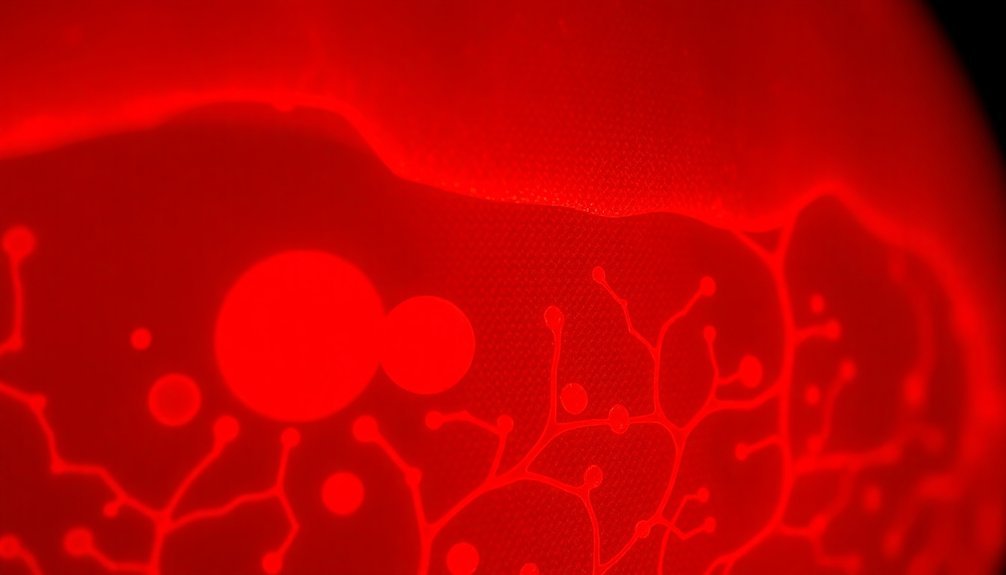
When light waves penetrate your fat cells during photobiomodulation, they trigger a process called lipolysis that releases stored fatty acids and glycerol.
Your cells respond to this light energy by ramping up their ATP production, which provides the necessary fuel for breaking down fat deposits.
This enhanced cellular energy not only powers the fat breakdown process but also activates key biochemical reactions that keep your metabolic function working efficiently.
The light energy creates transient pores in the fat cell membranes, allowing the released lipids to escape more easily.
Light Triggers Fat Release
Inside of fat cells, photobiomodulation sets off a remarkable chain of biochemical events that trigger lipolysis – the breakdown and release of stored fat. When LED light penetrates your adipose tissue, it stimulates your cells' mitochondria to produce more ATP, energizing the entire fat-release process.
This increased cellular energy activates hormone-sensitive lipase, an enzyme that's essential for breaking down stored fat.
The light therapy triggers your fat cells to release their contents in several ways:
- Your triglycerides break down into fatty acids, glycerol, and water that flow into surrounding tissue
- Your cells' metabolic rate increases, helping to process the released fat more efficiently
- Your cyclic AMP levels rise, enhancing the fat breakdown process
- Your lymphatic system activates to help flush out the released fat components
Your body then processes these broken-down fat components through natural metabolic pathways. Since photobiomodulation specifically targets unhealthy adipose tissue while preserving healthy fat cells, you'll maintain your body's natural fat-storage capacity.
This selective action means the results you achieve through light therapy can be permanent, especially when you maintain a healthy lifestyle.
Cellular Energy Boosts Breakdown
Through a remarkable process of cellular energetics, photobiomodulation supercharges your fat cells' metabolic activity by stimulating cytochrome c oxidase, a key enzyme in cellular respiration. This activation triggers a cascade of biochemical reactions that boost your cells' ATP production and enhance mitochondrial function, effectively turning up your body's energy-producing machinery.
When your fat cells receive this energy boost, they're prompted to release stored fat through enhanced lipolysis. You'll find your adipocytes actively breaking down triglycerides and releasing fatty acids and glycerol, while simultaneously reducing their fat storage capacity.
This process shifts your metabolism toward more efficient energy production through oxidative phosphorylation.
The increased cellular energy doesn't just affect fat breakdown – it improves your overall metabolic health. You'll experience better insulin sensitivity as your body reduces free fatty acid generation and plasma triglyceride levels.
The treatment activates specific pathways that inhibit fat-storing mechanisms while promoting fat breakdown, leading to improved body composition without invasive procedures.
This metabolic enhancement also supports better physical performance and recovery, making it an effective solution for stubborn fat deposits while maintaining your body's natural processes.
Cellular Changes During Treatment
When you receive photobiomodulation treatment, your cells experience a surge in ATP production that powers the breakdown of stubborn fat deposits.
Your mitochondria, the cellular powerhouses, kick into high gear as they respond to the light therapy, accelerating overall cellular metabolism and energy consumption.
During the course of treatment, your fat cells steadily decrease in size as they release their stored lipids, leading to measurable reductions in treated areas.
ATP Production Boosts Breakdown
The powerhouse of cellular energy production, ATP, plays a central role in photobiomodulation's fat-reduction effects. When PBM targets your cells' cytochrome C oxidase, it kicks your mitochondria into high gear, boosting ATP production and accelerating fat breakdown. This process starts when PBM removes inhibitory nitric oxide from COX, enhancing electron transport and increasing your cells' energy-producing capacity.
Your body's fat-burning potential gets amplified through several key mechanisms:
- Increased cyclic AMP levels activate hormone-sensitive lipase, which breaks down stored fat
- Enhanced mitochondrial function shifts metabolism toward more efficient energy production
- Released triglycerides from fat cells reduce overall fat volume
- Activated transcription factors promote protein synthesis and reduce inflammation
You'll experience measurable results as these cellular changes take effect. Clinical studies have shown significant fat reduction, including an average waist circumference decrease of 2.15 cm over just four weeks.
The therapy works by reversing enlarged fat cells to their normal state while improving glucose transport and reducing lipid buildup. It's a non-invasive approach that targets your body's natural fat-burning processes through enhanced ATP production.
Mitochondrial Function Accelerates
Inside your cells, photobiomodulation triggers a powerful acceleration of mitochondrial function, setting off a cascade of beneficial changes. When light reaches your mitochondria, it activates the cytochrome c oxidase (CCO), enhancing electron transport and boosting ATP production. This increased energy output directly supports your body's fat-burning processes.
Your mitochondria become more efficient through several key mechanisms. PBM strengthens their membrane potential and improves their overall redox balance, while simultaneously protecting them from oxidative stress damage.
You'll experience enhanced mitochondrial fusion, which helps maintain ideal cellular health and energy production. The treatment also increases nitric oxide production, improving blood flow to treated areas.
What's particularly remarkable is how PBM modulates your cellular signaling pathways. It creates just the right amount of reactive oxygen species to stimulate beneficial cellular responses while maintaining a healthy balance.
This controlled response activates transcription factors that promote cellular metabolism and protect against damage. Through these combined effects, your mitochondria work more efficiently, accelerating the breakdown of stubborn fat deposits while maintaining healthy cellular function throughout the treatment area.
Fat Cell Size Decreases
Through powerful cellular changes, photobiomodulation directly shrinks fat cells by triggering the release of stored triglycerides. This process activates multiple pathways that promote fat breakdown and cellular death of adipose tissue.
When you undergo red light therapy, your fat cells experience several key transformations:
- Your adipocytes release their fat content through a process called autophagic lipolysis, where cells fundamentally digest their own contents
- The therapy increases specific proteins like caspase 3 and CD68+ macrophages, signaling controlled cell death of fat cells
- Your body's hormone-sensitive lipase becomes more active, accelerating fat breakdown
- The inflammatory response in your abdominal fat tissue decreases, helping regulate blood glucose
As these changes occur, you'll benefit from improved insulin regulation and enhanced glucose metabolism. Your fat cells don't just shrink – they undergo a complete transformation through apoptosis, while your body mobilizes the released fat for energy use.
The therapy effectively reduces both free fatty acids and triglyceride levels, particularly beneficial if you're following a weight management program.
Breaking Down Stubborn Fat Deposits
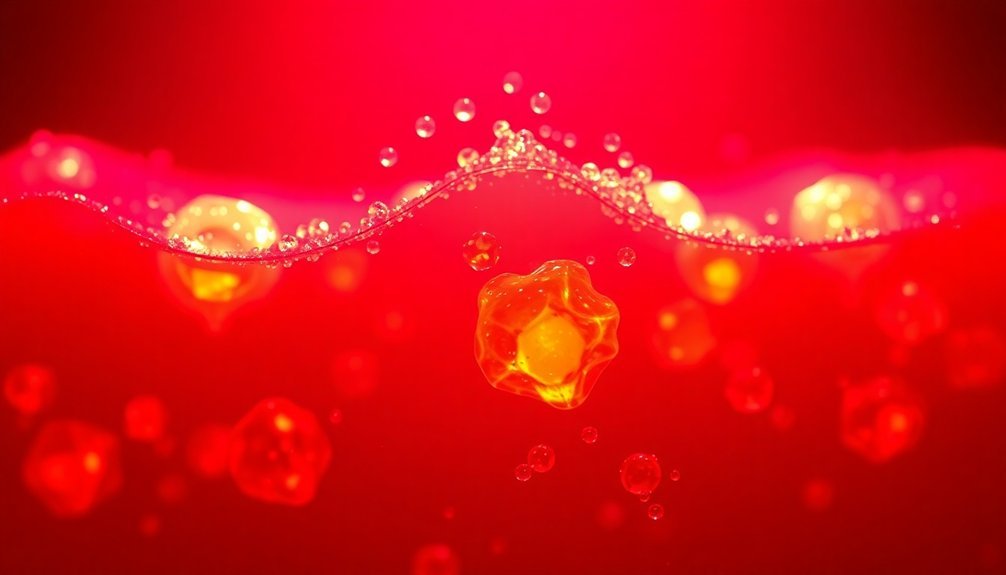
Breaking down stubborn fat deposits requires understanding photobiomodulation's precise biological mechanisms. When PBM targets your fat cells, it triggers several critical processes that work together to eliminate stubborn fat.
Your fat cells experience increased ATP production, which powers the breakdown of stored fat, while elevated cyclic AMP levels activate hormone-sensitive lipase – a key enzyme that accelerates fat metabolism.
During treatment, you'll benefit from enhanced lipolysis, where your fat cells release fatty acids, glycerol, and water into surrounding tissues for elimination. PBM also promotes autophagic lipolysis, causing problematic fat cells to undergo controlled cell death.
What's particularly significant is that unlike traditional fat-loss methods, PBM actually reduces the number of fat cells in treated areas rather than just shrinking them.
You'll see the most dramatic results when you combine PBM with healthy lifestyle choices. The treatment improves your overall metabolic function, which helps prevent fat from re-accumulating in treated areas. Studies have shown measurable results, with participants experiencing significant waist circumference reductions in as little as four weeks of treatment.
Light Therapy Versus Traditional Methods
Light therapy consistently outperforms traditional fat-reduction methods by targeting stubborn deposits at the cellular level. While diet and exercise focus on creating a caloric deficit, photobiomodulation works directly on your fat cells' metabolism, enhancing their breakdown through multiple pathways.
You'll find that traditional approaches often hit plateaus and struggle to address specific fat deposits, but light therapy actively stimulates fat cell reduction through enhanced ATP production and lipase activation.
What makes light therapy particularly effective is its ability to work synergistically with conventional methods. When you combine photobiomodulation with your existing weight management routine, you'll experience:
- Accelerated breakdown of stubborn fat deposits through targeted cellular mechanisms
- Enhanced metabolic efficiency and improved lipid profiles
- Better glycemic control and overall metabolic health
- Consistent results without the risks associated with invasive procedures
The science behind light therapy's effectiveness lies in its ability to trigger natural fat-reduction processes at the cellular level. Unlike traditional methods that may not effectively target visceral fat, photobiomodulation directly influences fat cell metabolism while promoting tissue health.
You're getting a safer, more targeted approach that works with your body's natural processes.
Clinical Results and Studies
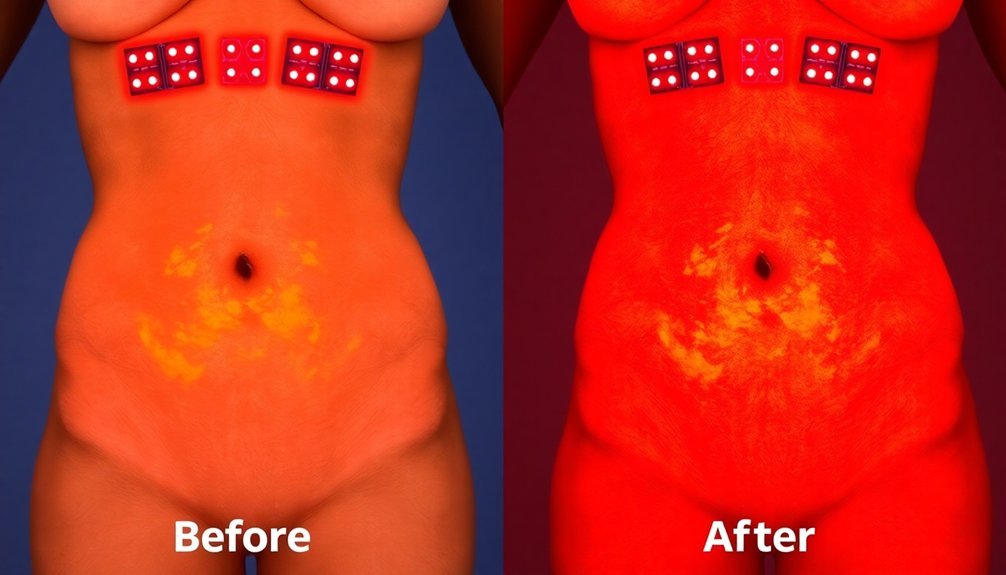
Clinical trials show you'll achieve measurable reductions in waist circumference and subcutaneous fat thickness through photobiomodulation therapy, particularly when combined with exercise.
You'll find the treatment's safety profile is well-documented across multiple studies, with minimal side effects reported during both short-term and medium-term use.
While research continues to explore the therapy's impact on glucose metabolism, current evidence points to positive metabolic changes when you undergo consistent treatment sessions.
Waist Reduction Research Data
Research findings consistently demonstrate photobiomodulation's effectiveness for waist reduction across multiple clinical trials. The most compelling studies show that twice-weekly low-level laser therapy (LLLT) treatments over six weeks can reduce waist circumference by approximately 0.8 inches (2 cm).
When combined with exercise, the results become even more pronounced, showing superior outcomes compared to placebo groups.
Clinical evidence supports several treatment protocols that have proven successful:
- 30-minute sessions at 127 J/cm² twice weekly for 4 weeks
- 20-minute treatments at 4.08 J/cm² three times weekly, combined with diet and exercise
- 8-session programs with follow-up evaluations at 15, 90, and 180 days
- Customized protocols using Monte Carlo simulation for ideal energy distribution
The science behind these results points to LLLT's ability to stimulate cytoplasmic lipase, converting triglycerides into fatty acids and glycerol. This process causes fat cells to shrink, leading to measurable reductions in waist circumference.
You'll find that photobiomodulation therapy (PBMT) has proven particularly effective compared to other treatments, such as non-contact selective-field radiofrequency, especially in reducing waist-to-hip ratio and subcutaneous abdominal fat thickness.
Impact on Glucose Metabolism
Groundbreaking studies reveal photobiomodulation's significant impact on glucose metabolism and insulin sensitivity. Research shows that PBM effectively reduces both fasting and post-meal blood sugar levels without increasing your risk of dangerous blood sugar drops.
When you receive PBM treatment, it activates a key enzyme called cytochrome c oxidase, which boosts your body's ATP production and enhances glucose uptake in your muscle cells.
You'll be interested to know that clinical trials across five continents have demonstrated PBM's effectiveness in improving insulin resistance and glucose tolerance. The therapy works by promoting GLUT4 translocation, which helps your muscles absorb glucose more efficiently. It also activates the PTEN/AKT signaling pathway, leading to better glycogen synthesis and storage.
What's particularly promising is PBM's ability to decrease free fatty acid production in your fat cells, which directly helps combat insulin resistance. The treatment also enhances mitochondrial function and reduces inflammation, contributing to better overall metabolic health.
These benefits make PBM a potentially valuable tool in managing blood sugar levels and supporting healthy glucose metabolism.
Safety Profile Evidence
Numerous clinical trials and safety studies have consistently demonstrated photobiomodulation's favorable safety profile across diverse applications. From targeted fat reduction to broader therapeutic uses, research confirms PBM's safety when proper protocols are followed.
Clinical trials examining various power levels up to 200 mW/cm² have shown no significant adverse effects, even in sensitive areas like ocular tissue.
Studies have particularly validated PBM's safety for fat reduction treatments, with research highlighting these key findings:
- Multiple clinical trials show no significant tissue damage when using standardized protocols, even with long-term application
- Animal studies confirm PBM's safety across different power settings and wavelengths, with no adverse systemic effects
- Controlled studies demonstrate superior safety compared to traditional fat reduction methods
- Research emphasizes the importance of personalized dosimetry based on individual tissue characteristics
What's particularly reassuring is that PBM's cellular and molecular mechanisms have been extensively studied. The treatment modulates inflammation and oxidative stress without causing harm to surrounding tissues.
This safety profile, combined with careful patient selection and monitoring in clinical settings, has established PBM as a reliable option for those seeking non-invasive fat reduction solutions.
Optimizing Your Treatment Protocol
Successful photobiomodulation treatment for fat deposits depends on three key factors: frequency, duration, and individualization. Your treatment protocol needs to take into account your body's unique characteristics, including skin thickness and fat tissue layers, to maximize results.
Research shows you'll achieve the best results by following specific treatment frequencies: three times weekly for 4 weeks, twice weekly for 6 weeks, or once weekly for 12 weeks. Remember, lower doses often work better than higher ones, following the Arndt-Schulz Law.
| Protocol Factor | What to Take Into Account | Best Practice |
|---|---|---|
| Frequency | Weekly sessions | 1-3 times per week |
| Duration | Treatment period | 4-12 weeks total |
| Power Density | Energy delivery | 5-10 mW/cm² |
Your protocol should account for your body's metabolic changes and fat cell reduction process. As PBM stimulates your fat cells, it triggers the release of triglycerides and activates cytoplasmic lipase. This process causes fat cells to shrink as fatty acids and glycerol pass through cellular pores. Work with your healthcare provider to develop a personalized treatment plan that takes into account your specific anthropometric variables for the best results.
Long-Term Fat Loss Benefits
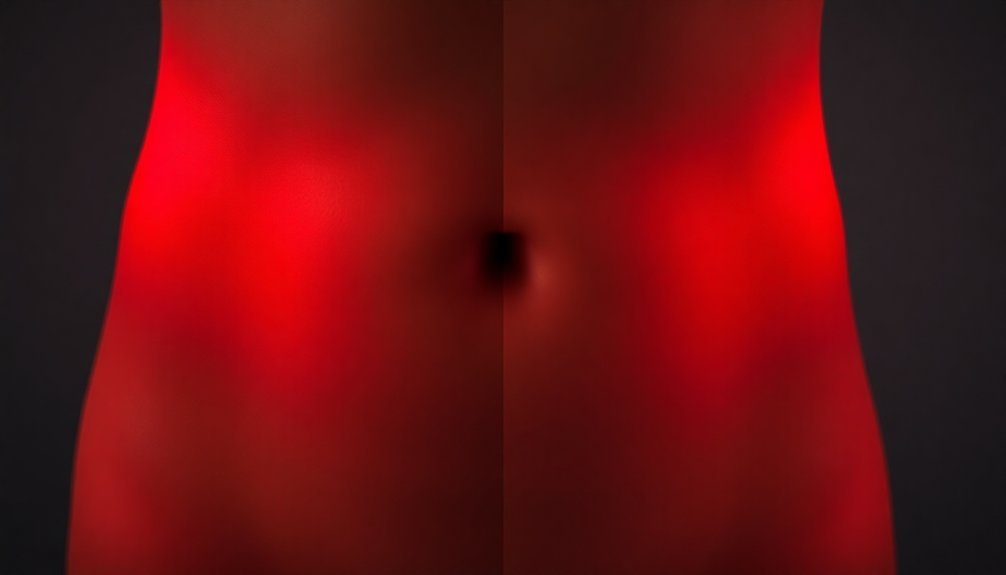
Moving beyond treatment protocols, recent scientific evidence confirms that photobiomodulation offers lasting fat reduction benefits through multiple biological mechanisms. When you undergo red light therapy, it triggers hormone-sensitive lipase activation and enhances your body's natural fat-burning processes through increased ATP production and improved metabolic function.
Clinical studies have demonstrated significant long-term results, including a 2.15 cm reduction in waist circumference after just four weeks of treatment.
When you combine photobiomodulation with regular exercise, you'll experience even more dramatic improvements in body composition:
- Enhanced fat breakdown through stimulated cellular metabolism and triglyceride release
- Improved glucose regulation and insulin sensitivity in adipose tissue
- Increased skeletal muscle mass and adiponectin concentration
- Better microcirculation for efficient oxygen and nutrient delivery
Your fat cells respond to red light therapy by releasing stored triglycerides, leading to reduced cell volume and measurable fat loss. This process continues working long after your treatment sessions, as photobiomodulation shifts your metabolism toward more efficient oxidative phosphorylation.
The non-invasive nature of this treatment guarantees you can safely maintain your results through consistent application.
Combining Treatments for Maximum Results
Through strategic combinations of treatments, you'll maximize the fat-reducing effects of photobiomodulation therapy. When you pair this treatment with regular exercise, you'll experience enhanced fat reduction and increased skeletal muscle mass. Your body's adiponectin concentration will rise, improving your metabolic flexibility and insulin regulation.
Combining photobiomodulation with a balanced diet amplifies your results. While you can't spot-reduce fat deposits, this combination promotes systemic fat loss and reduces cellulite's appearance through improved lymphatic drainage.
You'll benefit from enhanced cellular metabolism and ATP production, but remember that consistent dietary habits are essential for lasting results.
Unlike aggressive treatments such as laser body sculpting, you won't experience fat cell destruction with photobiomodulation. It's a safer, non-invasive alternative that works well with other body contouring techniques.
Clinical studies, including research by Dr. Michael Hamblin, confirm that combining photobiomodulation with exercise yields superior outcomes. Whether you choose LED or laser devices, both provide similar effectiveness for fat reduction.
As treatment protocols continue to evolve, you'll find personalized approaches that optimize your results while maintaining safety and efficacy.
Frequently Asked Questions
Can PBM Help Reduce Cellulite Appearance?
Yes, you'll see reduced cellulite appearance with PBM therapy. It works by improving skin temperature, boosting collagen production, and enhancing blood circulation. Clinical studies show it's especially effective when combined with exercise.
How Soon After Eating Should I Wait Before PBM Treatment?
You don't need to wait any specific time after eating before PBM treatment. The research doesn't show timing relative to meals affects results. Just focus on maintaining consistent treatment sessions for ideal benefits.
Does Wearing Clothing During Treatment Affect Pbm's Effectiveness?
Yes, your clothing will reduce PBM's effectiveness. You'll get better results with bare skin, but if you must wear clothes, choose thin, natural fabrics and consider extending your treatment time to compensate.
Can I Use PBM While Taking Medications for Diabetes?
Yes, you can use PBM while taking diabetes medications. Studies haven't shown negative interactions, and PBM may actually help improve glycemic control. However, it's best to inform your doctor about starting PBM therapy.
Will PBM Treatments Cause Skin Pigmentation Changes?
You'll likely notice positive changes in skin pigmentation during PBM treatments. It can help balance melanin production, reduce hyperpigmentation, and create more even skin tone through its effects on melanocytes and dermal health.
In Summary
You'll find photobiomodulation offers a science-backed approach to target those stubborn fat deposits. Whether you're using it alone or combining it with other treatments, this light therapy works at the cellular level to break down fat cells effectively. As you maintain a healthy lifestyle alongside your treatments, you can expect lasting results from this innovative fat-reduction method. Start your journey with realistic expectations and consistent sessions.
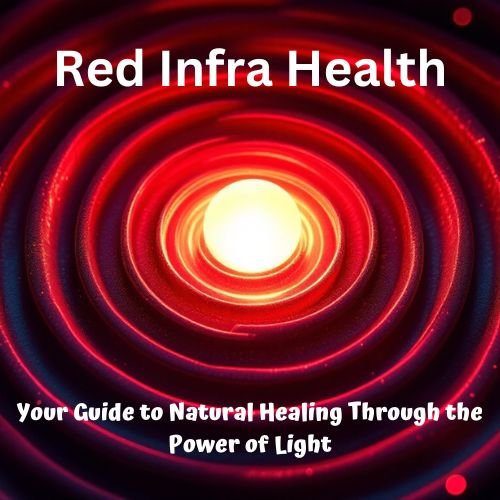
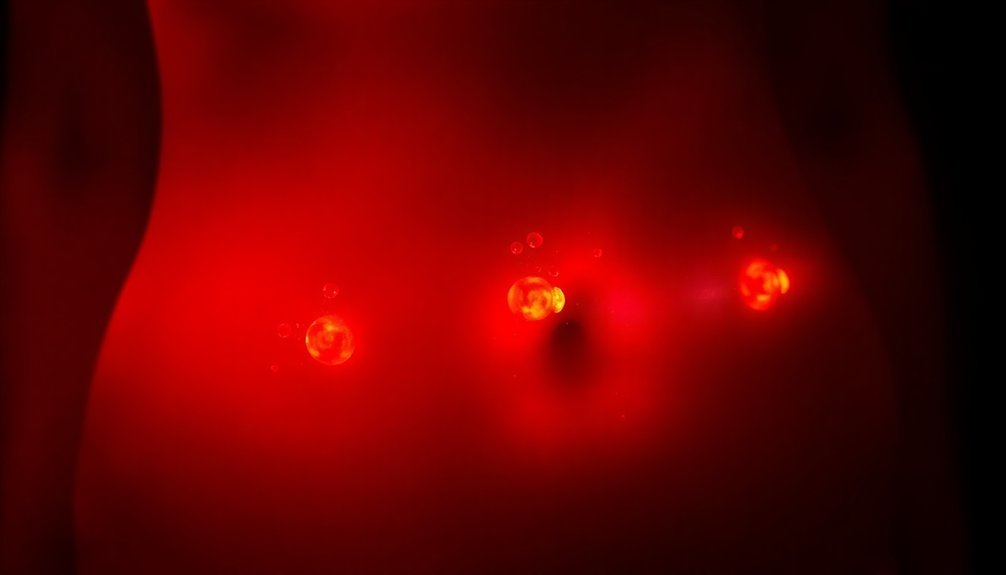



Leave a Reply